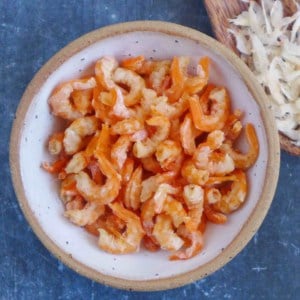A secret ingredient to rich umami taste, dried shrimp contributes to many delicious dishes. Here’s a how-to guide covering everything you need to know about it.
Dried shrimp are a versatile pantry staple used in many Asian cuisines. Their intense savory flavor makes them a secret weapon for adding rich umami taste to dishes. If you’re new to cooking with dried shrimp, you may be wondering – how do you use them?
From soup bases to stir-fries, dried shrimp can enhance the flavor of many dishes. Let’s discuss some easy ways to incorporate dried shrimp into your cooking
Dried shrimp are whole shrimp that have been sun-dried or dehydrated after being cooked. This drying process concentrates their flavor, resulting in a potent umami taste.
There are two main types of dried shrimp:
-
Regular dried shrimp – These are orange in color with the heads and shells removed, They come in sizes ranging from 1/3 to 1 inch long
-
Papery dried shrimp – Tiny dried shrimp with heads and tails intact. They have a beige color and crispy texture.
Dried shrimp are used in small amounts, but make a big impact on flavor. Their briny seafood taste can amplify soups, stir-fries, rice, noodles, and more.
Rehydrating Dried Shrimp
Before using dried shrimp in recipes, it’s important to rehydrate them. This rehydration unlocks their flavor and makes them easier to cut and incorporate.
To rehydrate:
-
Place dried shrimp in a bowl and cover with hot water.
-
Soak for 15-20 minutes until plump and softened.
-
Drain, reserving the soaking liquid which has concentrated shrimp flavor.
-
Chop rehydrated shrimp or use them whole per the recipe.
Note Papery dried shrimp can be used without soaking as they rehydrate during cooking
Easy Ways to Use Dried Shrimp
Here are some simple methods for cooking with rehydrated dried shrimp:
Enhance Soups and Broths
-
Add whole dried shrimp or chopped pieces to simmering soups and broths.
-
The shrimp will infuse the broth with savory flavor.
-
Try in wonton soup, miso soup, tom yum soup, chicken broth, and more.
-
Use the soaking liquid instead of plain water for extra flavor.
Boost Stir-Fries
-
Sauté chopped dried shrimp with aromatics like garlic and ginger.
-
Add to stir-fries with vegetables, tofu, pork, beef, etc.
-
They provide a tasty umami note to balance other ingredients.
-
Sprinkle whole tiny shrimp on top of stir-fries for texture.
Elevate Rice Dishes
-
Sauté dried shrimp with garlic, onion, soy sauce.
-
Add the mixture to fried rice, congee, rice porridge, etc.
-
The shrimp lend a subtle briny taste and aroma.
-
Garnish rice bowls with a few whole shrimp.
Mix into Noodle Dishes
-
Add hydrated shrimp, chopped or whole, to noodle soups and stir-fries.
-
They complement wheat, egg, rice, ramen, and glass noodles.
-
Use sparingly to avoid being overpowering in delicately flavored noodle dishes.
Make Shrimp Powder
-
Blanch and dry hydrated shrimp completely on paper towels.
-
Using a spice grinder or mortar and pestle, grind into a fine powder.
-
Shake powder through a fine mesh sieve to remove any fibrous bits.
-
Use shrimp powder to season sauces, marinades, soups.
Cooking Considerations
-
Dried shrimp have a pronounced flavor so use them sparingly. Start with 1-2 tablespoons per recipe.
-
Fry dried shrimp briefly to intensify their taste.
-
Pair dried shrimp with garlic, ginger, scallions, fish sauce, soy sauce, and curry powders.
-
If substituting for fresh shrimp, use about 1/4 the amount of dried shrimp called for in the recipe.
-
Soak in warm water only. Hot water makes them tough.
-
Store in an airtight container for up to 6 months.
Sample Recipes Using Dried Shrimp
Here are a few recipe ideas to inspire you:
Dried Shrimp Fried Rice
Sauté dried shrimp with garlic, onions, peas and carrots. Toss with cooled cooked rice, soy sauce, sesame oil, and scallions.
Hot and Sour Soup
Simmer dried shrimp and their soaking liquid with mushrooms, tofu, vinegar, chili oil, and soy sauce. Garnish with scallions.
Shrimp Paste Chile Dip
Blend dried shrimp into a smooth paste with garlic, fish sauce, lime juice, sugar, and Thai chiles. Enjoy with vegetables.
Shrimp Powder Seasoning
Grind blanched dried shrimp into a powder. Shake on popcorn, roasted vegetables, egg dishes, avocado toast.
Shrimp Summer Rolls
Rehydrate tiny dried shrimp and mix into rice vermicelli. Roll up with lettuce, cucumber, mint, and dipping sauce.
Frequently Asked Questions
Can I cook dried shrimp from their dried state?
It’s best to soak dried shrimp first to rehydrate them before cooking. Their texture will be unpleasant if cooked while very dry.
Do I need to remove the heads and shells?
Papery dried shrimp can be used whole. For larger ones, remove heads and most of shell before soaking. A few bits left on is ok.
Can I freeze unused dried shrimp?
Yes, dried shrimp can be frozen for longer storage. Portion into airtight bags and defrost before use.
What dishes pair well with dried shrimp?
Rice and noodles, soups, stir fries, congee, savory omelets, dim sum dishes, marinades, and dipping sauces all benefit from dried shrimp.
Can I use dried shrimp in vegetarian cooking?
Yes, but use them sparingly as they do have a pronounced seafood flavor. They add nice umami depth but shouldn’t dominate.
Get Creative with Dried Shrimp
While dried shrimp are common in Asian cuisine, don’t limit yourself. Get creative and add their intense savoriness to pasta, tacos, green salads, sausage mixes, and anywhere you want a flavor boost.
With their long shelf life and concentrated flavor, dried shrimp are a smart ingredient to keep stocked in your pantry. Follow these tips on rehydrating and cooking with dried shrimp to enhance everyday meals and bring restaurant-quality flavor to your kitchen.
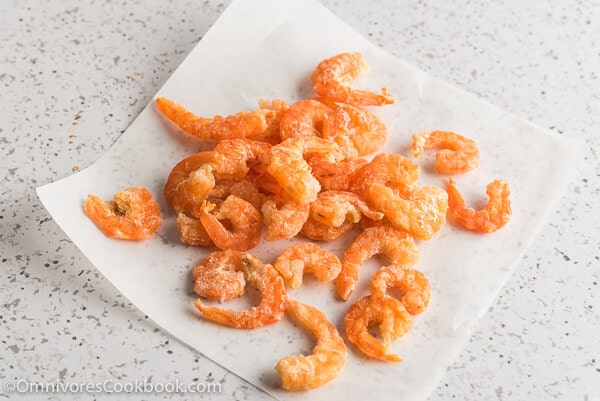
What is dried shrimp
Essentially, dried shrimp are sun-dried or baked (after being boiled) shrimp that has been completely or partially dehydrated. There is no dish that is made without them, but they are an important part of many classics that change how they taste.
To me, it is like an “unsung hero” in dishes. Even though its small size (often finely chopped) makes it easy to miss, the flavor it adds is rarely forgotten.
Like popular Asian ingredients like fish sauce or shrimp paste, dried shrimp gives food a unique umami (Xiān Wèi/鲻味) taste, which means savoriness and is one of the five basic tastes. It goes well with any ingredient, but I think it really shines in dishes that are mostly made with plant-based ingredients, like g. Tofu and Vegetable Soup, Turnip Cake, and more.
There are two types of dried shrimp used in Chinese cuisine: regular ones and papery ones.
Regular dried shrimp
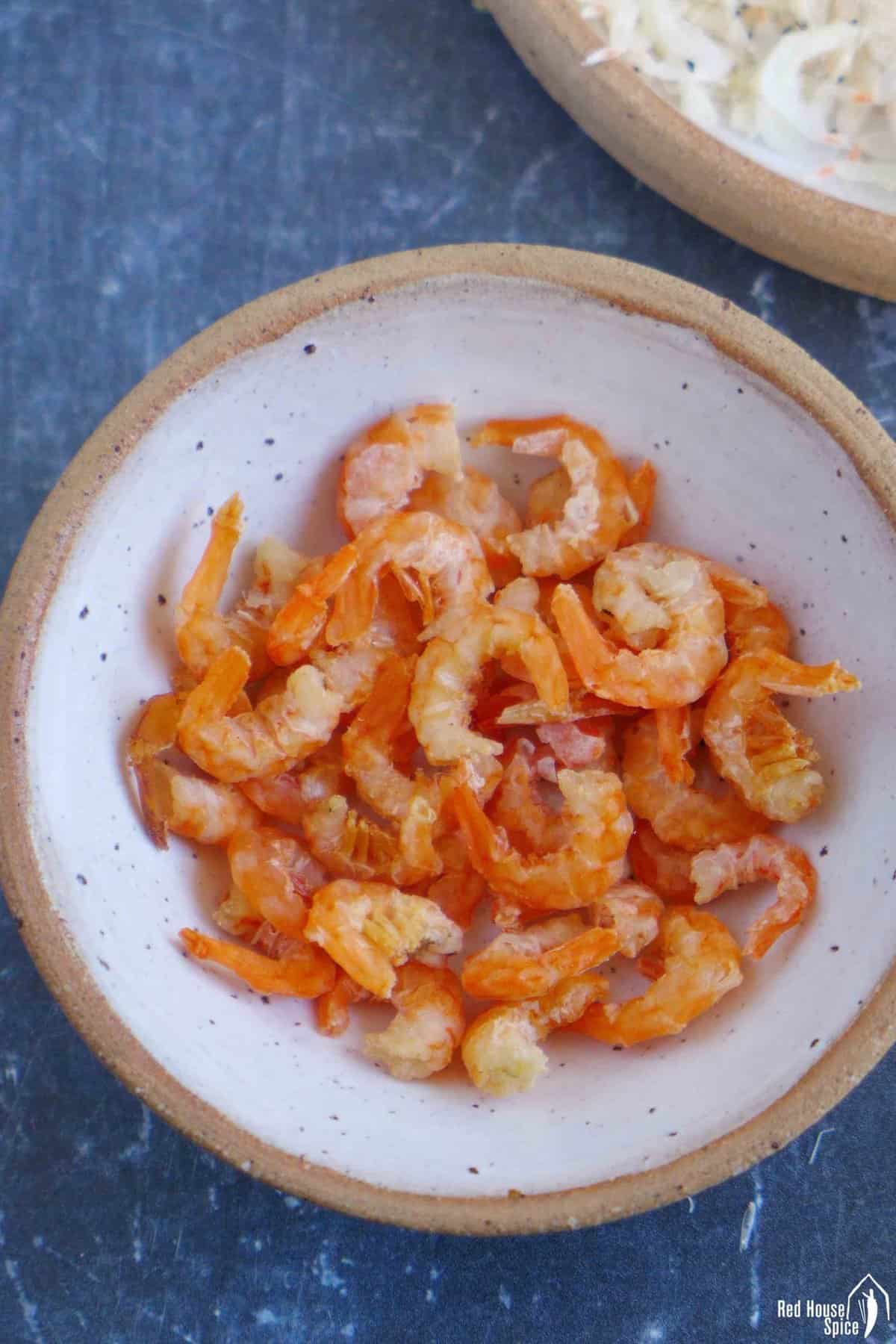
The most common one is known as Xiā Mǐ/虾米, Hǎi Mǐ/海米, or Gān Xiā Rén/干虾仁. They’re orange-looking, firm to the touch, and have their heads and most of the skin removed.
They come in different sizes, ranging from ⅓ to 1 inch (1-2½ cm). The bigger ones are usually more pricey, but I find smaller ones are equally good in flavor.
Papery dried shrimp
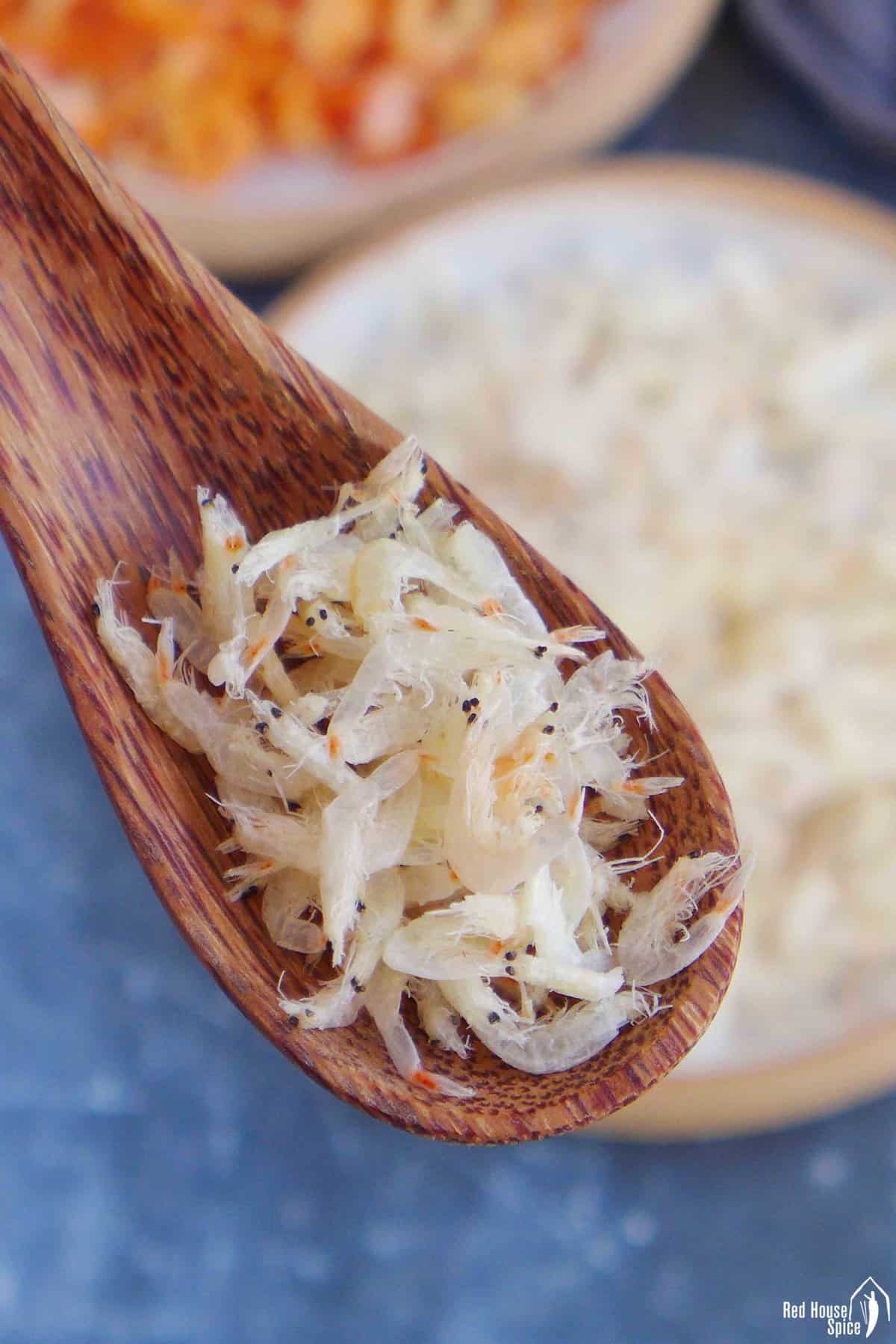
This type is known as Xiā Pí/虾皮, which means “shrimp skin” literally. They are tiny, beige-colored shrimp that have heads and tails intact. They don’t look as dry or firm as the regular version and have a crispy texture.
The taste of papery dried shrimp is milder than regular dried shrimp. It has a sweet undertone that I really like. They can be used directly without soaking.
You can cook dried shrimp in a lot of different ways, like in soups, broths, dumpling fillings, stir-fries, fried rice, fried noodles, braised or steamed dishes, and more.
Their flavor goes a long way, but they are only needed in small amounts most of the time. Here are a few general rules to follow when using them:
- If you are using regular ones, you will need to rehydrate them first (read more in the next section).
- Papery ones can be used directly without soaking.
- They can be chopped up, ground, or added whole to dishes to give them more texture.
- They can taste better if you fry them in a little oil.
The following recipes on the blog are great examples of using this flavorful ingredient:
Regular dried shrimp needs to be rehydrated before cooking. This process helps to release their aroma. Also, you’ll find it much easier to chop the softened ones into small pieces.
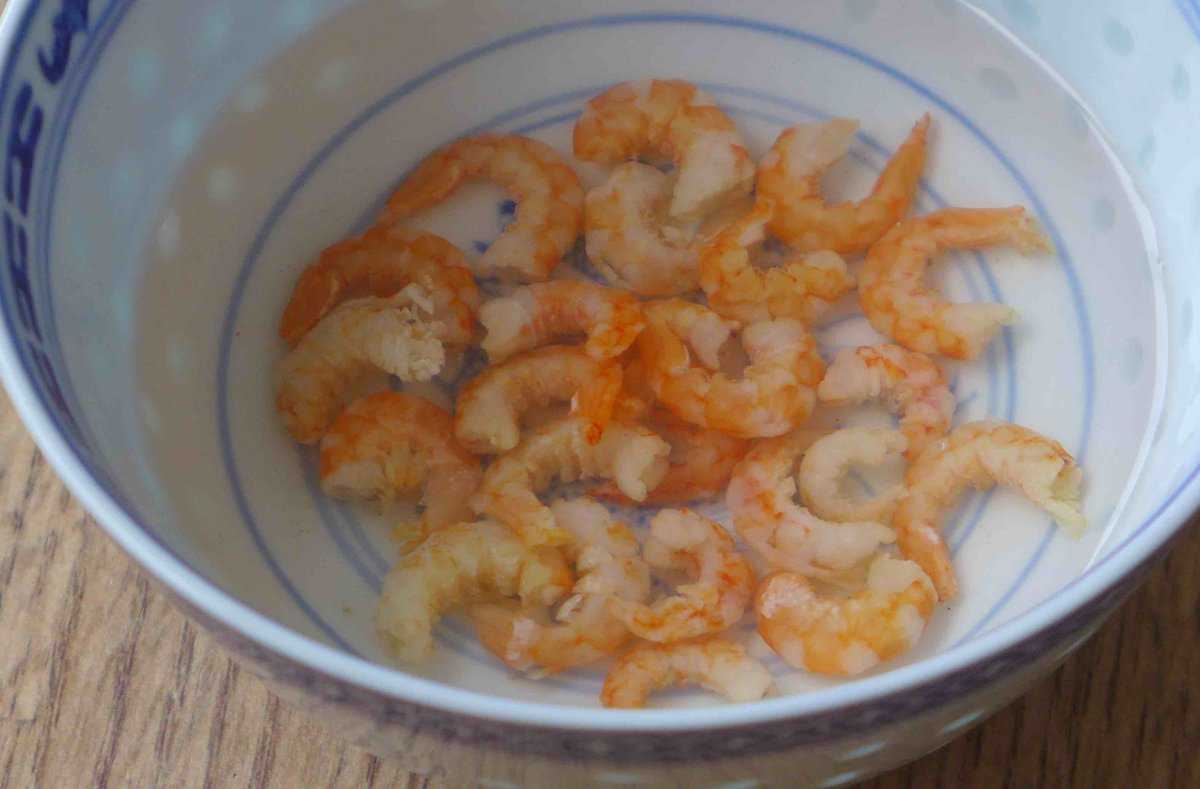
- Put as many dried shrimp as the recipe says to a small bowl. Then, add enough hot water to cover the shrimp completely. Soak them for about 10 minutes, or until they get soft and plump.
- If the shrimp are very small, you can use them whole, but if they’re bigger, you can cut them up.
Tip: Do not discard the water in which the dried shrimp has been soaked. It’s full of flavor and thus can be added to the dish you’re cooking. This is similar to how you’d use the soaking water for shiitake mushrooms.
Dried shrimp can be found in Chinese/Asian grocery stores. It’s usually in plastic packaging and kept in either the chilled or frozen food sections. Some online shopping platforms, such as Amazon, also have it in stock.
Good quality ones have uniform size and color. The regular kind should be bright orange, and the papery kind should have its whole body (head and tail not broken).

Once you open the package, put the dried shrimp in a container that won’t let air in. Keep it in the fridge to keep it fresh. Use it up in two months.
If you have bought a large amount, divide them into small portions and freeze in separate airtight bags. Consume before its expiry date.
If you find it hard to source dried shrimp, here are a few substitute options:
- Dried scallops (Gān Bèi/干贝)
- Shrimp paste (Xiā Jiàng/虾酱)
- Fish sauce (Yú Lù/鱼露)
No matter which one you use, make sure you limit its quantity. All of them have a rather concentrated flavor and are high in sodium.
